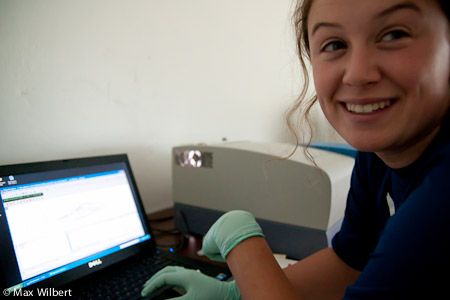This has been an event filled week. If you have been keeping up with the blog you might have realized a few things regarding the scientific aspects of the project:
a) this part of the world has a lot of frozen carbon from the Pleistocene era stored underground called Yedoma that has the potential to thaw as the earth warms,
b) the thawing of this carbon and transformation of this carbon into gases (e.g. carbon dioxide, methane, etc.) could have implications for climate change, however
c) measurements of how this carbon is transformed in the streams, lakes, rivers, and the ocean is not well understood since processing of carbon can dependent on a variety of factors (e.g. light, nutrients) that change in the landscape.
After 3 years of working on this project, I am extremely grateful to have instrumentation that allows us to track our projects in near real time. It is a real benefit for both students and professors since almost daily we are able to design and modify projects to understand part of the carbon transformation processes.
Yesterday for example, Lydia, one of the students from Carlton College, and I were talking about part of her study that determines how light might alter the carbon coming out of Yedoma. The experiment is rather simple where we wanted to add water extracted from Yedoma we call “Yedoma juice” to lake water and see how quickly the carbon was transformed and degraded with light. As you can imagine, light is freely available near Santa’s home in the summer time. We assumed the Yedoma juice had large carbon concentrations compared to the lake water. This assumption would allow us to detect the impact of light on the carbon atoms. Now that we have specialized equipment here at the station to analyze for the dissolved form of carbon, we found the lake water contained greater concentrations of dissolved carbon than the Yedoma juices we were going to add.
This poses a large problem for the experiment since the lake water would overwhelm the signal from the Yedoma juice and likely not allow us to detect any changes. Traditionally, we would have only known about this issue once we came back to our laboratory in the US where the machines to make these measurements are located. Both Lydia and I were pretty happy to have the new instruments here at the Northeast science station to help guide our experiments. Now we can redesign our work and continue to understand the carbon cycle here.
 It is great to be part of a team that has access to unique equipment in a remote location of the world. Learning about this place and its contribution to climate change would take a long time if you had to go back and forth between the US and Russia to conduct our measurements. It is nice to think quickly on our feet and modify our questions almost immediately so we can maximize the energy and investment it took to get here in the first place!
It is great to be part of a team that has access to unique equipment in a remote location of the world. Learning about this place and its contribution to climate change would take a long time if you had to go back and forth between the US and Russia to conduct our measurements. It is nice to think quickly on our feet and modify our questions almost immediately so we can maximize the energy and investment it took to get here in the first place!
That is all the news from the field,
Sudeep




Comment(1)-
Abby says
July 25, 2010 at 12:22 amI am impressed – great research and blog posts by all. The chickens are thriving and all is well, and hot, in NV. Can’t wait to have a drink when you get home.